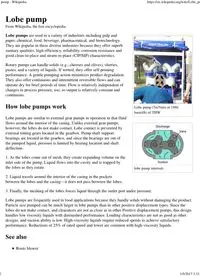
Lobe Pump-2017 PDF
Preview Lobe Pump-2017
Lobe pump (5m³/min or 1886 barrel/h) of THW lobe pump internals From Wikipedia, the free encyclopedia Lobe pumps are used in a variety of industries including pulp and paper, chemical, food, beverage, pharmaceutical, and biotechnology. They are popular in these diverse industries because they offer superb sanitary qualities, high efficiency, reliability, corrosion resistance and good clean-in-place and steam-in-place (CIP/SIP) characteristics. Rotary pumps can handle solids (e.g., cherries and olives), slurries, pastes, and a variety of liquids. If wetted, they offer self-priming performance. A gentle pumping action minimizes product degradation. They also offer continuous and intermittent reversible flows and can operate dry for brief periods of time. Flow is relatively independent of changes in process pressure, too, so output is relatively constant and continuous. Lobe pumps are similar to external gear pumps in operation in that fluid flows around the interior of the casing. Unlike external gear pumps, however, the lobes do not make contact. Lobe contact is prevented by external timing gears located in the gearbox. Pump shaft support bearings are located in the gearbox, and since the bearings are out of the pumped liquid, pressure is limited by bearing location and shaft deflection. 1. As the lobes come out of mesh, they create expanding volume on the inlet side of the pump. Liquid flows into the cavity and is trapped by the lobes as they rotate. 2. Liquid travels around the interior of the casing in the pockets between the lobes and the casing—it does not pass between the lobes. 3. Finally, the meshing of the lobes forces liquid through the outlet port under pressure. Lobe pumps are frequently used in food applications because they handle solids without damaging the product. Particle size pumped can be much larger in lobe pumps than in other positive displacement types. Since the lobes do not make contact, and clearances are not as close as in other Positive displacement pumps, this design handles low viscosity liquids with diminished performance. Loading characteristics are not as good as other designs, and suction ability is low. High-viscosity liquids require reduced speeds to achieve satisfactory performance. Reductions of 25% of rated speed and lower are common with high-viscosity liquids. Roots blower Lobe pump - Wikipedia https://en.wikipedia.org/wiki/Lobe_pump 1 of 2 1/5/2017 3:33 PM Wikimedia Commons has media related to Lobe pumps. PumpSchool.com Lobe Pump entry (http://www.pumpschool.com/principles/lobe.asp) Retrieved from "https://en.wikipedia.org /w/index.php?title=Lobe_pump&oldid=696390138" Categories: Pumps This page was last modified on 22 December 2015, at 20:48. Text is available under the Creative Commons Attribution-ShareAlike License; additional terms may apply. By using this site, you agree to the Terms of Use and Privacy Policy. Wikipedia® is a registered trademark of the Wikimedia Foundation, Inc., a non-profit organization. Lobe pump - Wikipedia https://en.wikipedia.org/wiki/Lobe_pump 2 of 2 1/5/2017 3:33 PM
